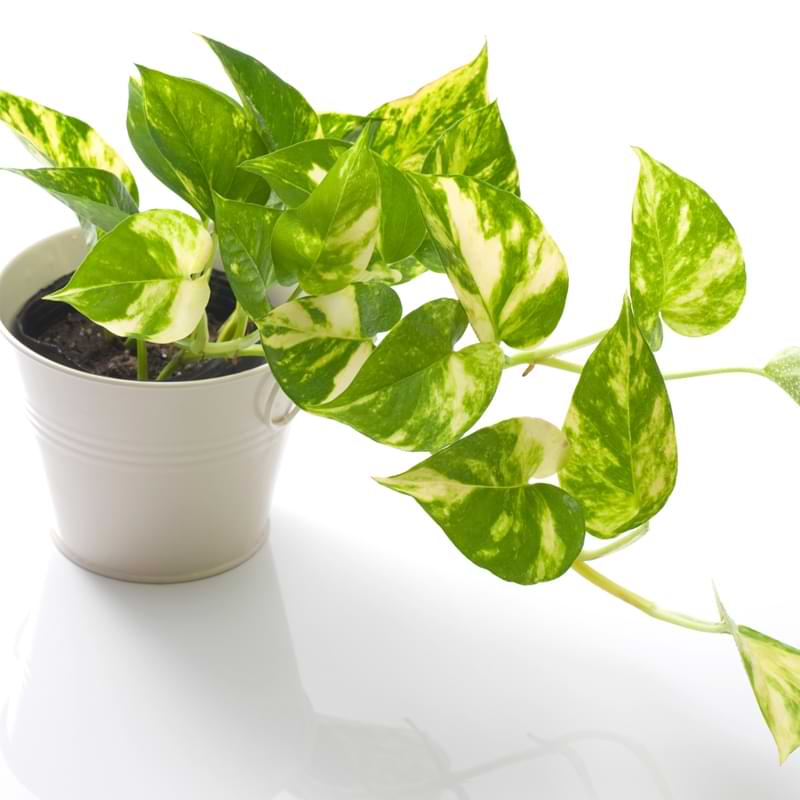Pothos plants are one of the most popular houseplants around – and for good reason! They’re easy to care for, they’re beautiful, and they purify the air. Here is our ultimate guide to help you care for your Pothos plant and help it thrive for years to come.
Table of Contents
What Is a Pothos Plant?
Pothos is the umbrella term for several varieties of climbing plants with waxy, heart-shaped leaves. The leaves can be solid green, or streaked with yellow, gold, or white. Some even have perforate leaves similar to the common Monstera! There are many varieties of Pothos plants, including the popular Golden Pothos, Marble Queen Pothos, Neon Pothos, the rare Harlequin Pothos, and more.
Is Pothos a Good Indoor Plant?
Pothos plants are a very popular indoor plant, and they’re fairly easy to care for, making them an excellent houseplant choice. Part of what makes them so popular is the variegated leaves that provide bright greenery with a pop of unexpected color, but they’re also very popular just for their sheer beauty.
They make an excellent indoor houseplant for several reasons, including how easy they are to care for, how beautiful they are, and how simple they are to propagate and make even more plants! If you’re just starting out on your houseplant journey, the Pothos plant is the best beginner plant for you.
Pothos Plant History
Pothos plants are native to tropical and subtropical regions of the world, particularly southeast Asia, and have been growing in popularity as houseplants in the Western world for centuries. Its botanical name is Epipremnum Aureum, and they are known for their ability to thrive in even the most neglected of environments.
Pothos plants are relatively easy to care for, and can tolerate a wide range of light and moisture levels. However, they require some basic care in order to thrive. Keep reading for a comprehensive pothos care guide!
Is Pothos and Devil’s Ivy the Same Thing?
It sure is! Although a strange name for a beloved houseplant, Pothos plants are commonly called Devil’s Ivy because they are extremely resilient and can survive even in rooms with little to no sunlight. Pothos is not an Ivy at all, but the name is catchy, so the nickname has stuck around.
How To Buy a Pothos Plant
When buying a pothos plant, there are a few things you need to keep in mind. First and most important, make sure you buy from a reputable source. There are many places that sell pothos plants, but not all of them are going to give you a healthy plant, and not all of them will stand behind their plants if disease takes it from you soon after bringing it home. Do some research to find a source that you can trust.
Once you’ve found a reputable source, look at the plants they have for sale. Make sure the plants are healthy and free of pests or diseases. Also, pay attention to the size of the plant. Pothos plants can vary in size, so make sure you choose one that will fit well in your space, and keep in mind that they can grow rather quickly with the right environment.
Finally, don’t forget to consider the price. Pothos plants are very affordable, but prices can still vary depending on the size, quality, and variety of the plant. With a little bit of shopping around, you should be able to find a great deal on a pothos plant that will suit your needs perfectly!
Caring For Your Pothos Plant
Pothos plants are one of the most popular house plants because they are easy to take care of, as long as you meet their basic needs. There are a few things you should know to keep them healthy and happy, and some ways to ensure your plant doesn’t succumb to some of the more common Pothos issues.
Water
Pothos plants like to be kept moist, but not wet. Water them when the top inch or so of soil is dry to prevent over-watering. I find that my Pothos thrives best when I bottom-water it.
To do this, simply fill a sink with about two to three inches of water, and place your potted pothos in the water standing upright. The soil will carry the water up to the plant through the drainage holes, and your plant will keep pulling water in until it is satisfied. Then simply drain the water from the sink and let it sit there to drain any excess water.
Only water your plant again when the top inch of soil has dried out. To be sure you’re not over- or under-watering, use a moisture meter like this one.
Light
Pothos plants do best in bright, indirect light. They can tolerate some direct sunlight, but too much sun will cause the leaves to scorch and dry out, and can kill your plant if left in these conditions for several days.
Although this plant will survive in various light conditions, it will thrive if it gets several hours of indirect sunlight or filtered sunlight.
An east-facing window will get the soft morning sun, while a west-facing window will get the harsher afternoon sun, so filter the sunlight if it is too harsh for your plant.
Temperature
Pothos plants are highly resilient, and can live in a range of room temperatures. However, for your Pothos plant to thrive, it prefers room temperatures between 60-80 degrees Fahrenheit.
Temperatures below 60 degrees for an extended period of time will result in your plant not producing a lot of new growth, and temperatures above 80 might risk your plant drying out and having to work too hard to survive. Either way, it can tolerate either end of those temperature ranges for a short amount of time without risking your plant’s overall health.
Fertilizer
Pothos plants benefit from monthly fertilization with a balanced, all-purpose fertilizer during the growing season (spring and summer). I prefer giving my plant a Pothos Plant Food that is specially formulated to give indoor plants all the nutrients they need to thrive indoors.
Repotting
Pothos plants can become pot-bound easily, so be sure to repot them into a larger pot every few years. Repotting is a simple process, and our comprehensive repotting guide can walk you through the entire process.
Pruning
You can prune your pothos plant to control its size and shape. Pruning also encourages new growth and gives you valuable cuttings that you can use to propagate new Pothos plants to share with friends and family!
Pothos plants can become quite leggy over time. To keep them healthy and looking their best, prune any brown or yellow leaves with sharp, clean pruning shears.
Are Pothos Plants Toxic?
Pothos plants are toxic to humans and animals. If any part of the leaves or stem is ingested, it can cause throat and tongue irritation, along with gastrointestinal upset. If you have pets or small children, it is best to keep pothos plants safely out of reach.
Can Pothos Plants Be Propagated?
Pothos Propagation is so easy, and it’s exciting to share a cutting with your best friends or your family. Even better, the process is simple. All you need is a stem with leaves, sharp pruning shears, and a pot with fresh, well-draining soil. For an in-depth guide to Pothos propagation, read our guide: Everything You Need to Know About Pothos Pruning and Propagation.
The basic steps are:
- Cut the stem below a leaf node, cutting at an angle.
- Stick the stem in a jar with clean water and change the water every 2-3 days.
- After you have a good set of roots growing, plant the stem in your well-draining soil and water it regularly.
Common Pothos Problems
Some of the more common problems with Pothos plants can easily be fixed, whereas others require more extensive care to get your plant back to health. Some of the more common issues we see in Pothos plants are outlined below.
Yellow Leaves
Yellow leaves on your plant can be tricky to treat, because there are many reasons for it to happen. Causes include over-watering, under-watering, root rot, or not enough light. Using a moisture meter will likely keep issues like this at bay.
Brown or Black Spots
Brown or black spots can have different causes also, and knowing your plant well will help you determine what the cause is. Brown spots or leaves can also be caused by over- or under-watering, but it could also be that the plant is getting sun burnt by too much direct light touching the leaves.
Black spots can be caused by low temperatures, over-watering, root rot, or a pest problem. Just make sure to inspect your plant regularly and you should be able to catch issues like brown or black spots before they become detrimental to your plant.
To help diagnose your plant and see some of the other more common issues Pothos owners may have to face, read our Pothos troubleshooting guide.
Pothos plants are one of the easiest and prettiest house plants you can add to your home. We love this plant for so many reasons, especially the fact that it’s incredibly easy to propagate and share with loved ones makes it even better!
Pothos plants are the perfect beginner plant, so if you’ve been considering getting an easy-to-care-for houseplant, the Pothos is definitely the right first choice. Remember to do your research first, and then go choose your new Pothos plant!
Houseplant Resources
Looking for more houseplant info? We highly recommend our super informative (and FREE!) Houseplants for Beginners Webinar. Check out our community of other plant lovers in our Facebook group. And if you’re looking for handy go-to reference for all your houseplant needs, check out our The Last Houseplant Book You Will Ever Need.






